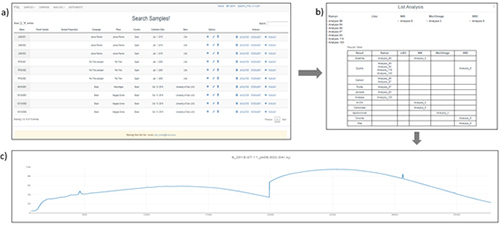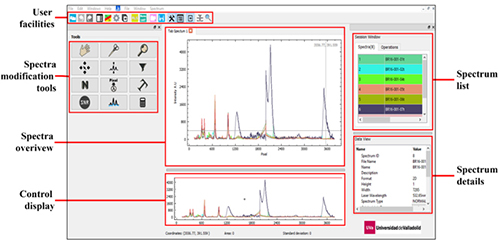Planetary Terrestrial Analogues Library (PTAL): online database platform and spectroscopic tools
- 1University of Valladolid, Ave. Francisco Vallés, 8, Boecillo, 47151 Spain. marco.veneranda.87@gmail.com
- 2Institut d’Astrophysique Spatiale, CNRS/ Université Paris-Sud, France.
- 3French National Centre for Scientific Research, IRAP, France.
- 4Centre for Earth Evolution and Dynamics, University of Oslo, Norway.
The PTAL Project: Mars2020/Perseverance 1 and ExoMars/Rosalind Franklin 2 rovers will look for traces of present or past life on Mars. To do so, the spectroscopic systems included in their analytical payloads will investigate the geochemistry and mineralogy of Martian rocks and soils to detect geological samples that could potentially host biomarkers. In order to optimize the scientific exploitation of planetary spectroscopic analysis, the PTAL project will provide the scientific community with a novel library of terrestrial analogue materials that have been selected based on their similarity to well-known Martian geological contexts. Funded by the European Union’s Horizon 2020 research and innovation programme under grant agreement Nº 687302, the PTAL online platform will be released to public in October 2021. As further detailed by Werner et al. during this conference, the core of the database are the spectroscopic data collected by means of multiple Raman (University of Valladolid, UVa, Spain), NIR (University of Paris-Sud, UP-Sud, France) and LIBS (French National Centre for Scientific Research, IRAP, France) systems. Spectroscopic results are additionally supported by X-ray diffractograms and thin section observations (University of Oslo, Uio, Norway) to provide an exhaustive geochemical and mineralogical characterization of the samples. The whole set of data, collected by means of both commercial systems and prototypes/flight spares (FS) of analytical instruments validated for Mars exploration (RLS-Sim, MicrOmega-FS, ChemCam-FS), will be available to the public thanks to a dedicated online platform, which main characteristics are detailed below.
The online PTAL platform:
The PTAL database will be accessible to public through the following URL: http://erica.uva.es/PTAL/. After login (credentials will be provided by the PTAL consortium upon request), future users will have access to the whole set of diffractometric and spectroscopic data collected from a total of 102 analogue materials. On one side, clicking on the sample name, the metadata associated to the selected terrestrial analogues are provided (e.g., Sample Name and Lithology, Sampling Campaign and coordinates) together with high quality pictures of the terrestrial analogue sample. On the other side, by clicking on “analytical summary”, the PTAL platform displays the list of NIR, LIBS, Raman and XRD analyses associated to the selected terrestrial analogue, together with a table summarizing and comparing the main results gathered from each technique (Figure 1).

Figure 1: Screenshots collected from the PTAL online database: a) list of samples, b) summary result of a selected analogue, and c) online visualization of a selected Raman spectrum.
At this stage, all NIR, XRD, Raman and LIBS data have been successfully uploaded to the PTAL database 3–5. In detail, the PTAL database provides access to 102 diffractograms (1 per sample), 102 LIBS spectra, 102 NIR spectra collected by means of the commercial spectrometer, and 102 NIR data cubes obtained through the MicrOmega system (of them composed of 62500 spectra collected at steps of 20µm in a field of view of 5x5mm). Regarding Raman results, only the spectra providing the highest mineralogical information were uploaded to the PTAL database. As such, the number of Raman spectra was reduced from over 4500 to 577 (an average of 5-6 spectra per sample). 245 of them were collected by means of the RLS-Sim, while the remaining 332 were obtained with a commercial spectrometer. All data can be either visualized online or downloaded for further data comparison and processing. In this framework, it must be underlined the PTAL platform also gives access to a dedicated software for data treatment. Named SpectPro, the details of this downloadable software are detailed below.
The SpectPro software:
Developed in the framework of the ExoMars mission 6, the PTAL version of the SpectPro software could be downloaded from the PTAL webpage (download section) for both windows and MacOs operating systems. Through the SpectPro software, PTAL users will be able to run individual and multi-spectra operations such as labelling, trimming, shifting, normalization, baseline correction (see Figure 2).

Figure 2: Screenshot of PTAL/SpectPro, in which the main functionalities and characteristics of the software are highlighted.
Among the main functionalities, the software also features a general-purpose spectrum calculator to perform lineal combinations, product and derivative of spectra, among others. The software team has been working to facilitate a direct access from SpectPro to the PTAL database, using the same credentials for access to the PTAL web interface. This connection will boost the capability of the scientist working in a planetary mission (but not only) to perform a fast and comprehensive characterization and identification of the mineral phases present in a sample by comparing the data obtained from the sample with the extensive spectral information included in the PTAL database. This will be possible by profiting from the navigation pane included in SpectPro. In addition, using the peak detection capabilities of SpectPro, it will be possible to perform sample identification based on the acquired spectra.
Acknowledgments: This work is financed through the European Research Council in the H2020- COMPET-2015 programme (grant 687302).
References: 1 Farley, K. A. et al. Space Sci. Rev. 216, 142 (2020); 2 Vago, J. L. et al. Astrobiology 17, 471–510 (2017); 3 Lantz, C. et al. Planet. Space Sci. 189, 104989 (2020); 4 Loizeau, D. et al. Planet. Space Sci. 193, 105087 (2020); 5 Veneranda, M. et al. J. Raman Spectrosc. 1–19 (2019) doi:10.1002/jrs.5652; 6 Lopez-Reyes G. et al. European Planetary Science Congress 2018 vol. 12 1–2 (2018).
How to cite: Veneranda, M., Saiz, J., Lopez-Reyes, G., Sanz-Arranz, A., Manrique, J. A., Medina, J., Loizeau, D., Lantz, C., Poulet, F., Cousin, A., Krzesińska, A. M., Dypvik, H., Werner, S. C., and Rull, F.: Planetary Terrestrial Analogues Library (PTAL): online database platform and spectroscopic tools, European Planetary Science Congress 2021, online, 13–24 Sep 2021, EPSC2021-105, https://doi.org/10.5194/epsc2021-105, 2021.

